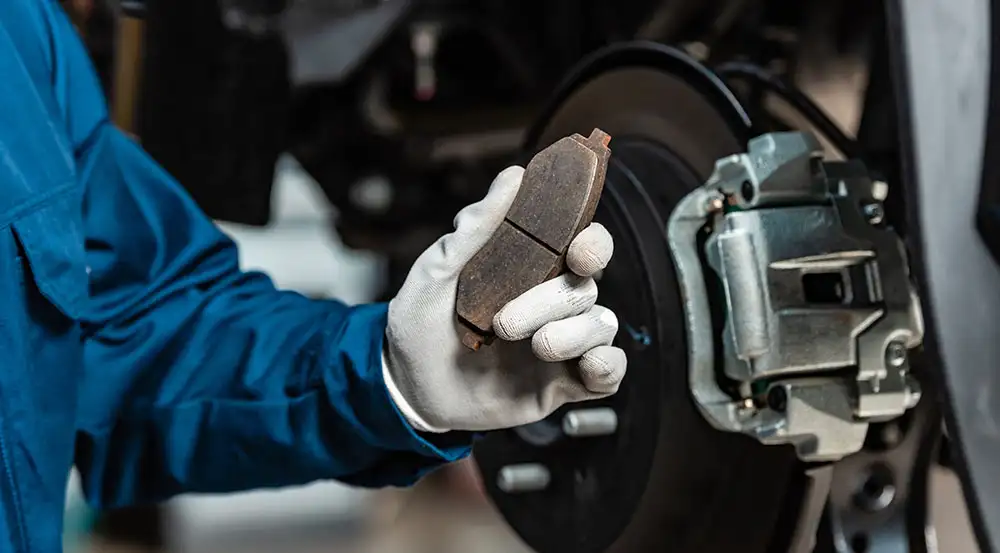Uneven brake pad wear occurs when one or more of your brake pads wear down faster than others, potentially leading to compromised safety and diminished braking performance. This issue often arises from a variety of underlying causes, including caliper malfunctions, rotor inconsistencies, or even improper installation. Understanding how to detect uneven wear and knowing its implications is crucial to ensuring your vehicle’s safety and longevity. In this guide, we’ll walk you through the key signs of uneven brake wear, possible causes, and what you should do if you suspect an issue.
Recommended reading: Signs that your brake pads need replacement
Key Signs of Uneven Brake Pad Wear
To ensure your brakes are functioning effectively, it’s essential to watch for these common signs of uneven wear:
- Vibrations While Braking
When you press the stopping pedal, the last thing you want is a vibrating or shaking sensation. This vibration can indicate uneven wear on your stopping pads or a warped rotor, which disrupts the smooth rotation of the wheels. Not only does this make driving uncomfortable, but it also compromises your ability to decelerate effectively. - Pulling to One Side
Does your car veer to one side when you decelerate? If so, this pulling effect often signals uneven stopping pad wear on one side. This could be due to issues with the calipers or an uneven rotor, causing one side of the vehicle to grip more effectively than the other. This uneven grip makes it harder to control your vehicle during braking, particularly on wet or icy roads. - Squealing or Grinding Noises
High-pitched squealing or grinding sounds are among the most common indicators of brake pad issues. A squealing noise usually suggests the brake pads have worn down significantly, while grinding could mean the pads are so worn that metal is making direct contact with the rotor. Both cases indicate a need for immediate replacement. - Inconsistent Brake Pedal Feel
If your stopping pedal feels soft, spongy, or inconsistent, it may be a sign of uneven wear. When one pad is more worn than the other, the hydraulic system can become imbalanced, causing irregularities in pedal pressure. This inconsistency can make it difficult to anticipate your deceleration response. - Uneven Pad Thickness
A quick visual check through your wheel spokes can reveal differences in stopping pad thickness. If you spot a significant variation in thickness between the pads on the same axle, it’s a clear indication of uneven wear. Regular inspection of pad thickness is crucial for spotting this issue early. - Longer Stopping Distance
Has it started taking more time to come to a complete stop? This increased stopping distance is often linked to uneven wear, which reduces the friction needed for effective braking. When pads wear unevenly, you lose valuable stopping power, which is particularly dangerous in emergencies.
What Uneven Stopping Pad Wear Means
Uneven pad wear isn’t just an inconvenience; it can seriously affect your vehicle’s performance and overall safety. Here are some critical aspects to consider:
- Potential Safety Hazard
Uneven stopping system wear can diminish braking efficiency, affecting your ability to stop quickly. With brake pads wearing unevenly, it reduces deceleration responsiveness and can lead to dangerous situations, especially during sudden stops. - Caliper Issues
Stopping system calipers play a key role in distributing pressure evenly across your pads. When there’s a problem with caliper pistons sticking or caliper guide pins wearing out, pressure can become unevenly applied. This inconsistency leads to one pad wearing faster than the other, which in turn affects your stopping stability - Rotor Problems
Warped or worn rotors also contribute to uneven stopping pad wear. An uneven rotor surface creates inconsistent contact with the pads, leading to faster wear on one side. Addressing rotor issues is essential to prevent ongoing stopping system wear problems.. - Improper Installation
Proper deceleration pad installation is crucial for even wear. Misaligned pads can make partial contact with the rotor, causing certain areas to wear faster. It’s essential to have your stopping system installed by a professional to avoid premature wear and ensure that all components work harmoniously. - Faulty Brake Hardware
Small components such as clips, springs, and bushings play an essential role in holding your stopping pads securely in place. When these components wear down or become misaligned, they can allow pads to shift, leading to uneven contact with the rotor and faster wear.
What to Do if You Suspect Uneven Stopping Pad Wear
If you notice any signs of an uneven stopping system, it’s crucial to address the issue promptly to prevent further damage and maintain safe driving conditions. Here’s what to do:
- Get a Professional Inspection
A qualified mechanic can perform a comprehensive inspection to identify the root cause of uneven wear. They’ll check the stopping pads, calipers, rotors, and other components to determine the source of the problem. - Consider Possible Repairs
Depending on the diagnosis, repairs may include replacing worn brake pads, machining or replacing warped rotors, cleaning and lubricating caliper guide pins, or resolving caliper issues. Regular brake maintenance can help prevent issues like these from recurring. - Practice Preventive Maintenance
Staying on top of regular stopping system maintenance can help prevent uneven wear. Schedule brake inspections at regular intervals, especially if you frequently drive in high-traffic or stop-and-go conditions.
Why Choose Mission Auto Repair?
At Mission Auto Repair, we understand the importance of having a reliable brake system to keep you safe on the road. Our experienced technicians are equipped to handle all types of inspections and repairs, from replacing worn pads to diagnosing caliper or rotor issues. Trust Mission Auto Repair to keep your vehicle’s retard in top condition and to help you drive with confidence.
FAQs
Q: What causes uneven brake pad wear?
A: Uneven wear is often due to caliper issues, rotor problems, improper installation, or contaminants on brake components.
Q: How do I know if I need new brake pads?
A: Signs such as squealing noises, vibrations while decelerating, pulling to one side, or longer stopping distances can indicate that it’s time to replace your stopping pads.
Q: How can I check brake pad wear?
A: You can visually inspect your stopping pads through the wheel spokes or have a mechanic check them. Look for signs of uneven thickness or excessive wear on one side.
Q: How do I identify which brake pads are worn?
A: A mechanic can identify which stopping pads are worn during an inspection, checking for uneven wear across all four wheels.
Q: What does uneven brake pad thickness mean?
A: Uneven thickness indicates that one pad is wearing faster than the other, often due to issues with the calipers or rotors, which may need repair.


